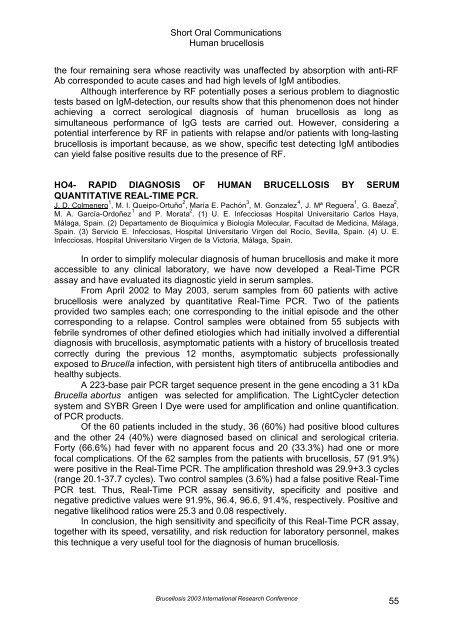Brucellosis 2003 proceedings - PHIDIAS
Brucellosis 2003 proceedings - PHIDIAS
Brucellosis 2003 proceedings - PHIDIAS
You also want an ePaper? Increase the reach of your titles
YUMPU automatically turns print PDFs into web optimized ePapers that Google loves.
Short Oral Communications<br />
Human brucellosis<br />
the four remaining sera whose reactivity was unaffected by absorption with anti-RF<br />
Ab corresponded to acute cases and had high levels of IgM antibodies.<br />
Although interference by RF potentially poses a serious problem to diagnostic<br />
tests based on IgM-detection, our results show that this phenomenon does not hinder<br />
achieving a correct serological diagnosis of human brucellosis as long as<br />
simultaneous performance of IgG tests are carried out. However, considering a<br />
potential interference by RF in patients with relapse and/or patients with long-lasting<br />
brucellosis is important because, as we show, specific test detecting IgM antibodies<br />
can yield false positive results due to the presence of RF.<br />
HO4- RAPID DIAGNOSIS OF HUMAN BRUCELLOSIS BY SERUM<br />
QUANTITATIVE REAL-TIME PCR.<br />
J. D. Colmenero 1 , M. I. Queipo-Ortuño 2 , María E. Pachón 3 , M. Gonzalez 4 , J. Mª Reguera 1 , G. Baeza 2 ,<br />
M. A. García-Ordoñez 1 and P. Morata 2 . (1) U. E. Infecciosas Hospital Universitario Carlos Haya,<br />
Málaga, Spain. (2) Departamento de Bioquímica y Biología Molecular, Facultad de Medicina, Málaga,<br />
Spain. (3) Servicio E. Infecciosas, Hospital Universitario Virgen del Rocío, Sevilla, Spain. (4) U. E.<br />
Infecciosas, Hospital Universitario Virgen de la Victoria, Málaga, Spain.<br />
In order to simplify molecular diagnosis of human brucellosis and make it more<br />
accessible to any clinical laboratory, we have now developed a Real-Time PCR<br />
assay and have evaluated its diagnostic yield in serum samples.<br />
From April 2002 to May <strong>2003</strong>, serum samples from 60 patients with active<br />
brucellosis were analyzed by quantitative Real-Time PCR. Two of the patients<br />
provided two samples each; one corresponding to the initial episode and the other<br />
corresponding to a relapse. Control samples were obtained from 55 subjects with<br />
febrile syndromes of other defined etiologies which had initially involved a differential<br />
diagnosis with brucellosis, asymptomatic patients with a history of brucellosis treated<br />
correctly during the previous 12 months, asymptomatic subjects professionally<br />
exposed to Brucella infection, with persistent high titers of antibrucella antibodies and<br />
healthy subjects.<br />
A 223-base pair PCR target sequence present in the gene encoding a 31 kDa<br />
Brucella abortus antigen was selected for amplification. The LightCycler detection<br />
system and SYBR Green I Dye were used for amplification and online quantification.<br />
of PCR products.<br />
Of the 60 patients included in the study, 36 (60%) had positive blood cultures<br />
and the other 24 (40%) were diagnosed based on clinical and serological criteria.<br />
Forty (66.6%) had fever with no apparent focus and 20 (33.3%) had one or more<br />
focal complications. Of the 62 samples from the patients with brucellosis, 57 (91.9%)<br />
were positive in the Real-Time PCR. The amplification threshold was 29.9+3.3 cycles<br />
(range 20.1-37.7 cycles). Two control samples (3.6%) had a false positive Real-Time<br />
PCR test. Thus, Real-Time PCR assay sensitivity, specificity and positive and<br />
negative predictive values were 91.9%, 96.4, 96.6, 91.4%, respectively. Positive and<br />
negative likelihood ratios were 25.3 and 0.08 respectively.<br />
In conclusion, the high sensitivity and specificity of this Real-Time PCR assay,<br />
together with its speed, versatility, and risk reduction for laboratory personnel, makes<br />
this technique a very useful tool for the diagnosis of human brucellosis.<br />
<strong>Brucellosis</strong> <strong>2003</strong> International Research Conference<br />
55
















